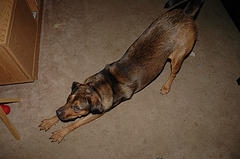
This dog trick isn’t just cool, it’s also useful.
Your friends will be impressed if you get your dog to take a bow after a spree of other tricks, but even more impressive is the trick’s ability to defuse tension between dogs.
The “take a bow” pose is the same pose dogs use to show submission and playfulness between each other.
Dogs and people who’ve never met your dog before, will feel calmer once they see your dog take a bow.
Preparing to Teach the “Take a Bow” Dog Trick
This is an optional step for dogs who get into the “take a bow” pose on their own. The most common time this happens is when they stretch. Stretching after sleep often has your dog rump-up, and his fore legs way ahead of him – just like taking a bow.
To capture the behavior, you simply click every time your dog is in that pose. After the click, toss your dog a treat. That will help your dog learn that this is a pose you want him to learn.
Instructions for Teaching the “Take a Bow” Dog Trick
Follow this guide to teaching “take a bow” over a period of a couple weeks, and your dog will be the family show-off! Remember to repeat each step until your dog masters it completely. (Before beginning, you should have already introduced your dog to the target stick and charged the clicker.)

- Your dog should be standing in front of you for this step. Put the target stick at the level of your dog’s nose, and lower it to the floor.
Give a click and a treat any time your dog follows the stick toward the floor, even just a bit.
Repeat until he’s following the tip of the target stick downward reliably.
- Repeat the above, but don’t click or reward your dog until his front elbows bend.
- Do the same as above, but now you wait for his elbows to touch the floor before you click and treat.
- Keep at it, but withhold the click and other rewards until his elbows are resting on the floor and his hind legs are straight. That’s the complete “take a bow” pose.
- Now, continue the same program but withhold the click and the treats until your dog stays in the “take a bow” position for two seconds or longer.
- Start using the command word. Choose a command word or phrase and stick with it forever. “Stretch” is a little easier to learn, but “Take a bow” is more impressive for onlookers!
Present the target stick, say the command word, and immediately move the target stick toward the floor. As above, click and give a treat for each success.
- Phase out the target stick, using the command phrase instead. You can phase out the target stick by grasping it closer to the tip, or by only lowering it the first inch.
- Remove the target stick from the lesson and use only the command phrase. This step might take more practice than the others. If your doesn’t seem to “get it” without the command stick, go back to the previous step.
- Phase out the clicks and treats. Tell your dog to “take a bow” and praise him for successes, but give clicks and treats less often.
- Proof the trick by performing it in different places, in places with lots of distractions, and with different company.
Teaching “Take a Bow” – Troubleshooting

If your dog lowers his rump to the floor instead of keeping his hind legs straight:
- If his elbows hit the floor before he bends his hind legs, toss the treat before his hind legs bend.
- Use your hand or some obstruction under your dog’s belly to keep him from laying down.
Other troubleshooting steps for teaching the “take a bow” dog trick:
- Remove all distractions whenever you begin training a new behavior.
- Training sessions should be short and fun – long, boring training sessions make it harder to learn.
- This isn’t the easiest dog trick to learn. Make sure your dog has completely mastered each step before you move on. Repeat even after he’s mastered it, to really build up your dog’s mastery.
- However, don’t teach too slowly, either. Watch your dog’s expressions when you’re teaching “take a bow,” you should be able to tell whether he’s excited or bored.
Have fun, and good luck! Once your dog masters “take a bow,” you should have little or no trouble with any other trick-training tasks.
Return to dog training for beginners, or go back to training a dog to do tricks.

